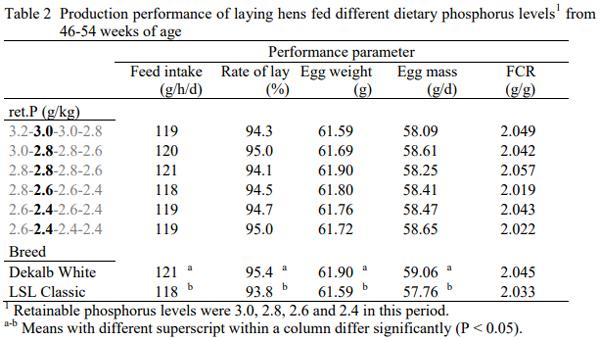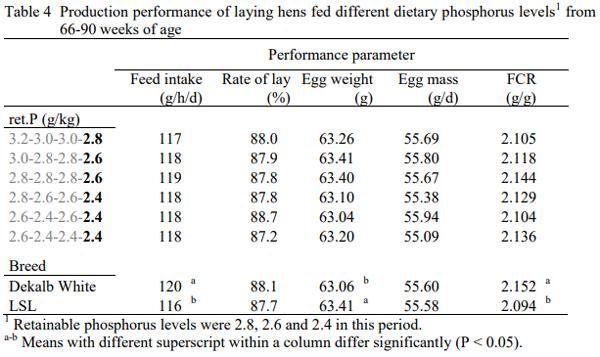Introduction
Phosphorus is an important nutrient for laying hens, e.g. for bone development and egg formation, but also plays an important role in environmental contamination. However, research on the phosphorus requirement of laying hens is dated (Van der Klis and Blok, 1997). The modern laying hen with a high egg number and laying persistency probably has a different phosphorus requirement than birds from 20 to 30 years ago. Furthermore, age and level of physical activity, which is related to housing system, are two important factors in the phosphorus requirement and utilisation of laying hens as reviewed by Lambert et al. (2014). On the one hand, aged laying hens have a less active bone metabolism to utilise calcium and phosphorus well. On the other hand, egg production will decrease in aged birds, thereby reducing the requirement for phosphorus. Laying hens housed in non-cage systems seem to have an improved phosphorus utilisation, which might reduce the phosphorus requirement. Aim of the study was to determine the effect of age and breed on retainable phosphorus (ret.P) requirement and utilisation of the laying hen housed in an aviary system.
Materials and methods
The trial consisted of six dietary treatments (T1 to T6) differing in ret.P level. The trial was divided in four phases (36-45, 46-54, 55-65 and 66-90 weeks of age) in which the following diets were supplied: T1) 3.2-3.0-3.0-2.8 g ret.P/kg, T2) 3.0-2.8-2.8-2.6 g ret.P/kg, T3) 2.8-2.8- 2.8-2.6 g ret.P/kg, T4) 2.8-2.6-2.6-2.4 g ret.P/kg, T5) 2.6-2.4-2.6-2.4 ret.P/kg, T6) 2.6-2.4- 2.4-2.4 g ret.P/kg. All diets met or exceeded nutrient requirements of laying hens according to Dutch standards (CVB, 2007), except for dietary ret.P level. No phytase was added to the diet. Effects were evaluated with two layer breeds, LSL Classic and Dekalb White, housed in a semi-commercial multi-tier aviary system. Each diet × breed treatment was performed with three replicates (330 birds per replicate). Production was measured per phase. At 35, 45, 60, 75 and 90 weeks of age P content in faeces, carcass, and eggs was determined, as well as egg quality (breaking strength and Haugh Unit).
The experimental data were analyzed by analysis of variance (General Linear Models procedure) using GenStat statistical software (15th edition). Data were analysed according to the following model:
Yij = μ + Blocki + Treatmentj + Breedk + Interactionjk + eijk
where Y is the response parameter, μ is the overall mean, Block is the effect of replicated block (i = 1 to 3), Treatment is the effect of dietary treatment (j = 1 to 6), Breed is the effect of layer breed (k = Dekalb, LSL), Interaction is the effect of Treatment × Breed, and e is the random error term. Treatment means were compared by least significant differences (LSD). P < 0.05 was considered to be statistically significant, whereas 0.05 ≤ P < 0.10 was considered to be a near-significant trend.
Data on P content in faeces, carcass, and eggs, as well as egg quality are not analysed yet. Retainable P requirement during start of lay was not measured and will be extrapolated.
Results
Results on production performance are given in Table 1 to 4. Dietary ret.P level did not affect production performance in any phase. Therefore, a ret.P level of 2.6 g/kg seems to be sufficient for maximal egg number, egg weight, egg mass and feed conversion ratio from 36- 54 weeks of age. From 55-65 weeks of age, laying rate and feed conversion ratio were respectively numerically highest and lowest at a ret.P level of 2.6 g/kg, whereas egg weight and egg mass were highest at a ret.P level of 2.8 g/kg. In the last phase of production (66-90 weeks of age), feed conversion ratio was lowest at a ret.P level of 2.4 and 2.8 g/kg. Although Treatment 5 and 6 had the same low P level during the last phase, Treatment 5 with the alternated P-supply performed better than Treatment 6 during this period. Dekalb White hens had a higher feed intake, laying rate, egg weight and egg mass from 36-54 weeks of age than LSL Classic birds. From 55 weeks of age onwards, laying rate, egg weight and egg mass are similar between breeds. Dekalb White hens still had a higher feed intake, resulting in a higher feed conversion ratio.
Conclusion
Although not significant, results indicate that a ret.P requirement of 2.6 g/kg is sufficient until 65 weeks of age. Thereafter, it is not clear what P-level will be sufficient for maximum production performance. This has to be shown by the data on P content in faeces, carcass, and eggs.
Presented at the European Poultry Conference 2014.














.jpg&w=3840&q=75)